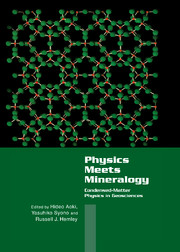Book contents
- Frontmatter
- Contents
- Preface
- List of Contributors
- Part I Introduction
- Part II Advances in Theoretical and Experimental Techniques
- Part III New Findings in Oxides and Silicates
- Chapter 3.1 Search for a Connection Among Bond Strength, Bond Length, and Electron-Density Distributions
- Chapter 3.2 MgO – The Simplest Oxide
- Chapter 3.3 First-Principles Theoretical Study of the High-Pressure Phases of MnO and FeO: Normal and Inverse NiAs Structures
- Chapter 3.4 Computer-Simulation Approach to the Thermoelastic, Transport, and Melting Properties of Lower-Mantle Phases
- Part IV Transformations in Silica
- Part V Novel Structures and Materials
- Part VI Melts and Crystal–Melt Interactions
- Subject Index
- Materials Formula Index
- Index of Contributors
Chapter 3.2 - MgO – The Simplest Oxide
Published online by Cambridge University Press: 05 November 2011
- Frontmatter
- Contents
- Preface
- List of Contributors
- Part I Introduction
- Part II Advances in Theoretical and Experimental Techniques
- Part III New Findings in Oxides and Silicates
- Chapter 3.1 Search for a Connection Among Bond Strength, Bond Length, and Electron-Density Distributions
- Chapter 3.2 MgO – The Simplest Oxide
- Chapter 3.3 First-Principles Theoretical Study of the High-Pressure Phases of MnO and FeO: Normal and Inverse NiAs Structures
- Chapter 3.4 Computer-Simulation Approach to the Thermoelastic, Transport, and Melting Properties of Lower-Mantle Phases
- Part IV Transformations in Silica
- Part V Novel Structures and Materials
- Part VI Melts and Crystal–Melt Interactions
- Subject Index
- Materials Formula Index
- Index of Contributors
Summary
Periclase, or MgO, is a simple ionic mineral, but one in which many-body interactions are important. The thermal equation of state, elasticity, melting, thermal conductivity, and diffusivity have been studied by use of first-principles methods, i.e., from fundamental physics. There is generally good agreement with experiment. Studies of MgO provide fundamental information on the high-pressure behavior of minerals in the deep Earth.
MgO, periclase, is the simplest oxide and has been a subject of intense experimental and theoretical study. Oxides and silicates make up the bulk of the Earth's mantle and crust, and thus it is important to understand and predict their behavior. The behavior of MgO, as the prototypical oxide, is the key to understanding mineral and rock behavior in the bulk of the Earth. An important feature of MgO is the nonrigid behavior of the oxygen O2– ion, which makes the interactions not describable by pairwise interactions. All other more complex oxides share this feature and add additional complications as well. MgO is simple in that it is an ionic material with no solid-state phase transitions until over 500 GPa according to the best computations. If we understand MgO we will not immediately understand all other oxides and silicates, but if we cannot understand MgO, we cannot understand any other oxide or silicate.
There is an enormous literature on MgO, and a comprehensive review is impossible here. Instead the main thrust is on the underlying fundamental physics of MgO. First-principles methods, as opposed to empirical methods, are emphasized. Properties that are addressed range from the thermal equation of state and elasticity to properties of defects, surfaces, and impurities.
- Type
- Chapter
- Information
- Physics Meets MineralogyCondensed Matter Physics in the Geosciences, pp. 95 - 123Publisher: Cambridge University PressPrint publication year: 2000
- 8
- Cited by



